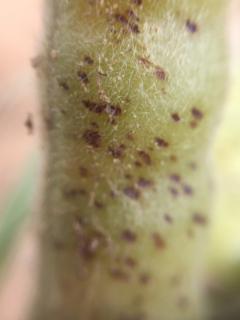Brown spot in lupins
- Mingenew
- Moorine Rock
Crop protection officer Bonnie Jupp (DPIRD) has found what is suspected to be brown spot in lupins near Mingenew. The crop was at the pod ripening stage.
Biosecurity officer Cameron Wild (DPIRD) reports finding brown spot in lupins at the pod ripening stage near Moorine Rock.
Brown spot (Pleiochaeta setosa) spores are present in soils where lupins have been grown previously. Lupin leaves infected with brown spot drop to the ground and spores are produced on the dead tissue. These spores become incorporated into the surface layers of the soil and remain dormant there. Spores can persist in the soil for several years through non-lupin rotations, although their population reduces over time.
Spores are splashed by rain from the soil surface onto leaves of lupin plants resulting in the appearance of dark brown lesions which can distort leaves and result in premature defoliation. Oldest leaves are affected first. Newly emerged seedlings and young plants are at greatest risk of brown spot infection. Brown spot can occasionally develop in the mid-upper canopy of lupin crops following heavy rainfall. Pods, particularly those set closer to the ground, may be flecked or develop larger brown lesions.
The same fungus causes both brown leaf spot and Pleiochaeta root rot in lupins. Disturbance of the soil through cultivation and sowing can incorporate the spores into the root zone resulting in a higher risk of Pleiochaeta root rot for the next lupin crop.
Plant pathologist Geoff Thomas (DPIRD) says that the impact of brown spot can be reduced through rotation of crops, the use of seed dressings and through measures which reduce spore splash such as retention of cereal stubble. Foliar sprays are ineffective and no products are registered.
As lupin rotations have widened and with greater levels of cereal stubble retention reducing soil splash, severe brown spot is less common, although lupin crops will often have low levels of disease symptoms on lower older leaves.
For more information refer to the department’s Diagnosing brown spot in narrow-leafed lupins.
For more information contact Geoff Thomas, Plant Pathologist, South Perth on +61 (0)8 9368 3262.

